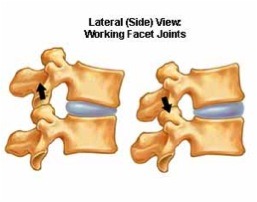Cervical spine structure
- The cervical spine begins at the base of the skull and is comprised of 7 vertebrae (C1 through C7), 7 cervical discs, and 8 pairs of cervical nerves.
- The cervical vertebrae are designed to support the skull, protect the spinal cord, and allow movement of the head.
- The first two cervical vertebrae, known as the Atlas (C1) and Axis (C2) have different features than C3-C7. The atlanto-occipital joint (between the skull and C1) provides the majority of flexion for the neck. The atlanto-axial joint (between C1 and C2) is where the majority of neck rotation occurs.
- Facet joints are formed where the vertebra above makes contact with the vertebra below. As the neck is flexed, extended, rotated and side bent, these joints move in a sliding motion.
Cervical spine function
- There are many muscles and ligaments that attach to the cervical spine. Ligaments act to restrict excessive
 movement of the spine. Muscles act to forward flex, rotate and side bend the spine. Some muscles act to produce large movements of the head and neck, while others play an important role in postural stability.
movement of the spine. Muscles act to forward flex, rotate and side bend the spine. Some muscles act to produce large movements of the head and neck, while others play an important role in postural stability. - Discs are found between each vertebra and act as a cushion. They are comprised of a softer inside portion called the nucleus pulposus, and a fibrous outer ring known as the annulus fibrosus.
- At each vertebral level, a pair of spinal nerves exits the spinal column through an opening called the intervertebral foramen. These nerves supply motor and sensory function to the head, neck, upper limbs, and diaphragm.
Potential sources of neck pain
- Muscular tension, often related to poor posture or an injury, can cause neck pain and restricted movement.

- Disc injury can cause neck pain, and if the injury is large, it may press on nerves and cause pain extends down the arm.
- Arthritis can develop in the joints of the cervical spine, causing pain and possibly restricting movement
Tips for a healthy cervical spine
- Maintaining good posture throughout the day minimizes the stress placed on all the structures of the neck. Developing good postural habits may be the single most important factor for preserving the health of the cervical spine.
At Sydney Physiotherapy Solutions our highly qualified physiotherapists specialise in the assessment, treatment and prevention of neuromusculoskeletal injuries.
Contact us today – 9252 5770
This handout was prepared by Sydney Physiotherapy Solutions and is intended as a general information service. Please note that the information provided is not intended as a substitute for advice from a registered physician or healthcare professional. If symptoms persist, please consult your doctor.

